What is black and white and coveted all over? Yes, truffles. Recently I had an opportunity to visit a truffle market in the south of France. I had heard about French truffle markets from several people.
My friend Caroline, who grew up near the Rhône Valley in Provence, was the first to tell me about the markets for the so-called “Black Diamonds.” She reported on the Richerenches truffle market a little over a year ago for a post called Truffle Season. Her description made such an impression that I longed to see a truffle market for myself. I was also coaxed and literally guided by Sharon deRham, an American who relocated to Provence and is an exceptional tour guide. (If you’re looking for a guide, I highly recommend her.) I was debating which truffle market to visit. Carpentras has a weekly truffle market on Fridays, but we decided to drive a little farther to experience the one in Richerenches on Saturday.
The earthy, musky aroma reached my nose as soon as we parked near the market. Richerenches hosts both a wholesale and a retail truffle market. The two are separated onto different streets.
Professionals huddle on Cours du Mistral conducting high-stakes negotiations, while laid-back shoppers stroll the neatly laid out retail stalls along avenue de la Rabasse. (“Rabasse” is the Provençal word for truffle.) The moods of the two markets couldn’t be more different. In the wholesale market, sellers with stern faces stand by the trunks of their cars which are parked under large shadowy branches of plane trees. The transactions are hushed and hard to observe.
Sometimes slips of paper with prices scribbled on them are passed between sellers and buyers to keep the negotiations private. Once purchased, the truffles are often tucked into pillowcases and secreted away. Large amounts of cash trade hands. (This is a cash-only market.) Clouds of mystery and intrigue fill the air almost as much as the scent of truffles.
Only a block away at the retail market, the ambience is more relaxed. Shoppers can examine and buy truffles, along with truffle oils, mandolines for slicing them, and other truffle products.
Anyone who wants to try growing truffles and has the patience to wait nearly 10 years until they possibly yield an edible harvest can buy oak saplings with truffles attached.
In addition to all the truffles and truffle paraphernalia, there are also cheeses, nougats, local eggs, honeys, jams, mushroom varieties such as cêpes, trompettes, and girolles, and more.
Richerenches enjoys a reputation as the most important truffle market in Europe. Roughly 60% of France’s highly prized black diamond truffles (tuber melanosporum) are unearthed in the hills and villages of Vaucluse and Drôme and then sold at the Richerenches market. Black diamonds are also called “Périgord truffles,” but in fact only about 20% come from the Périgord region in the southwest.
There are other kinds of black truffles besides the tuber melanosporum, such as the lighter flavored Bourgogne, or Burgundy, variety (tuber uncinatum), which Elaine Sciolino describes in this article from The New York Times. There’s also the tuber brumale which reaches maturity at the same time and often occupies the same territory as the tuber melanosporum but has a sharper, more pungent smell. Many snub these other varieties as inferior in flavor and aroma.
Monsieur Valayer, one of the sellers at the wholesale market, allowed us to peer into his bag and admire several truffles large as baseballs. As I touched the pebbly black skins, he explained, “The more evenly round, the better. It should be firm and not too spongy. It takes a savvy buyer to recognize a true melano from a brumale.”
France produces about 30-40 tons of black truffles each year. That’s a far cry from the roughly 400 tons per year in the 1920s. Climate change is largely responsible for the dramatic decline in quality and production. The devastating effects of two world wars and other changes in natural habitat, such as the development of vineyards, have also contributed.
Black truffles peak in January, February, and March. They’re less ripe and tasty earlier in the season. I overheard one chef say that he wouldn’t consider cooking with truffles until at least January. Not surprisingly then, the truffle markets draw their biggest crowds between January and March.
While most people come to Richerenches for truffles, the town’s colorful history is another reason to visit. Monsieur André Charransol, formerly the mayor (and shown in the photo earlier, admiring M. Valayer’s truffles), gave us a tour. He explained that the Knights Templars, an Order founded in the 12th century to protect the tomb of Christ and Christian pilgrims, went through Europe looking for money and members. Initially a poor Order, the Commanderies des Templiers established their French base in 1136 in Richerenches.
Thanks to the agricultural resources around Richerenches, the Templars headquarter quickly grew in size and clout. It became so wealthy and powerful that the King of France, Philippe le Bel, pressured the Pope to close it down in 1307. The Templar Knights were imprisoned, the Order was dissolved a few years later, and Molay, who had been head of the Order in Richerenches, was burned at the stake in Paris. The Commanderie building and the farmland around Richerenches fell into ruin. The Pope inherited the property that had belonged to the Templars (the villages of Richerenches, Grillon, and Visan) and purchased Valréas. All became part of the “Enclave des Papes.”
In the 16th century, the Pope distributed the land to ten local families. They rebuilt the town of Richerenches and the area farms. Ramparts were erected in the 16th century for protection. After the revolution, around 1790, the locals voted to be part of Vaucluse (even though not contiguous with it) because they wanted to continue to be part of Provence. The tourist office does a good job of presenting this story.
A ritual known as the Truffle Mass (la Messe des Truffes or a Messe de St. Antoine) started in 1952 and continues to this day. (Here’s an excellent video of the Black Truffle Mass, taken by Ginger & Nutmeg.) The patron saint, Saint Antoine, who is depicted with a pig, became an apt symbol for truffle hunters. The yearly truffle mass is held in his honor on the third Sunday of January. Truffle producers donate about 5 kilos which are auctioned off. And it’s no small potatoes. In 2014, they got about 1000 euros per kilo. All proceeds go to the parish. The mass is a lavish and colorful affair, which includes a parade with spectators coming from all over the world to witness la Confrérie de la messe conduct the service. The local church was lovingly restored recently. Santons and a stained glass window infuse the space with soft colors and a proud sense of the local history.
A highlight of the Richerenches truffle market is the village’s omelette lunch at the Salle des Fêtes from 11:30 am-1 pm on many Saturdays during truffle season. People sit at long community tables and fill the entire room. In the small kitchen, hardworking women churn out one gooey omelet after another.
For 21 euros per person, you can feast on a truffle omelet, salad, wine, apple tart, and coffee. Each serving has been pre-measured to include 10 grams of truffles and 3 eggs per omelet.
Local musicians often attend the lunch as well. The day I was there, a man pulled out a trombone, another a French horn, one woman went for her tuba, and another drums.
The crowd joined singing and clapping. It was a fitting celebration for a locally grown product that has brought prosperity and pleasure to this village for generations.
Details:
The Richerenches truffle market is open Saturdays in winter, starting the first Saturday after November 15 through March, from 9 am-1 pm. Avenue de la Rabasse for the retail market; Cours du Mistral for the wholesale market. Richerenches Tourist Office: Place Hugues de Bourbouton, 84600 Richerenches. Tel: 04.90.28.05.34 Website: www.richerenches.fr Email: tourisme.richerenches@orange.fr. Contact the tourist office for the schedule of truffle lunches and make your reservation well in advance (through them) since they sell out quickly.
The Carpentras truffle market is held on Friday mornings at 9 am at the Hotel-Dieu from mid-November through the end of March.
Video of the annual Mass of the Black Truffle taken by Ginger & Nutmeg.


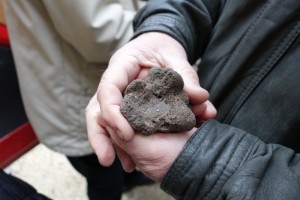
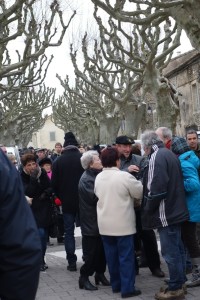
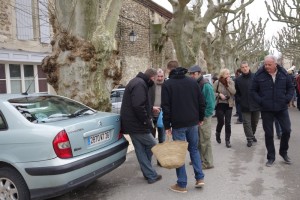
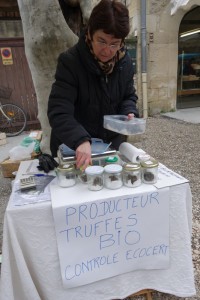

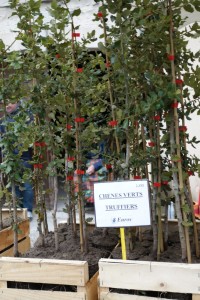
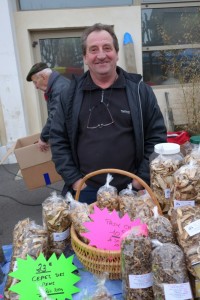
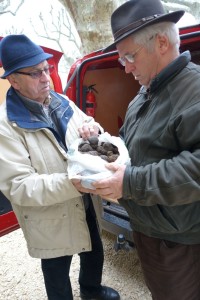
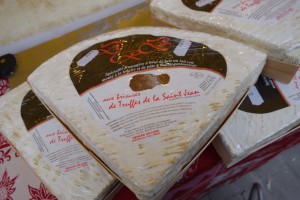
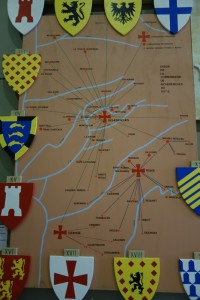
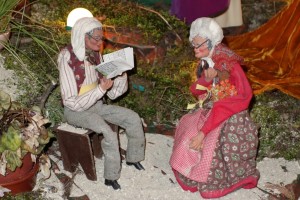
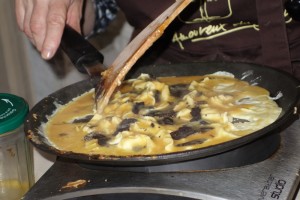
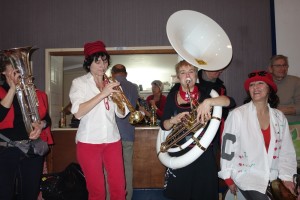
6 comments. Leave new
just met a friend’s sister who goes to the Oregon Truffle festival every year, and also has bought trees and spores. She planted them three years ago, and has another four to wait!!! Now to get a truffle hound! Not the same, but , well……..
I hope she’s got patience. (And gets the hound soon, since training can take years!)
Hey Marjorie,
Great post!
Maybe we’ll see you on the truffle circuit next year…
🙂
Thanks, Julie. Would love to meet up on the truffle circuit sometime!
Hi,
This is a really good post. I also visited these markets this season and the description is spot on. All the info is correct and these markets need to be seen to be believed! Lovely town and great people. I would suggest that the only error is the picture with the mandolin….that is NOT truffle being sliced it is a black radish! Other wise really fun to read another perspective.
A black radish? Wow. I wish I’d taken a closer look or taste. Thanks for that correction and for your comments! ~Marjorie